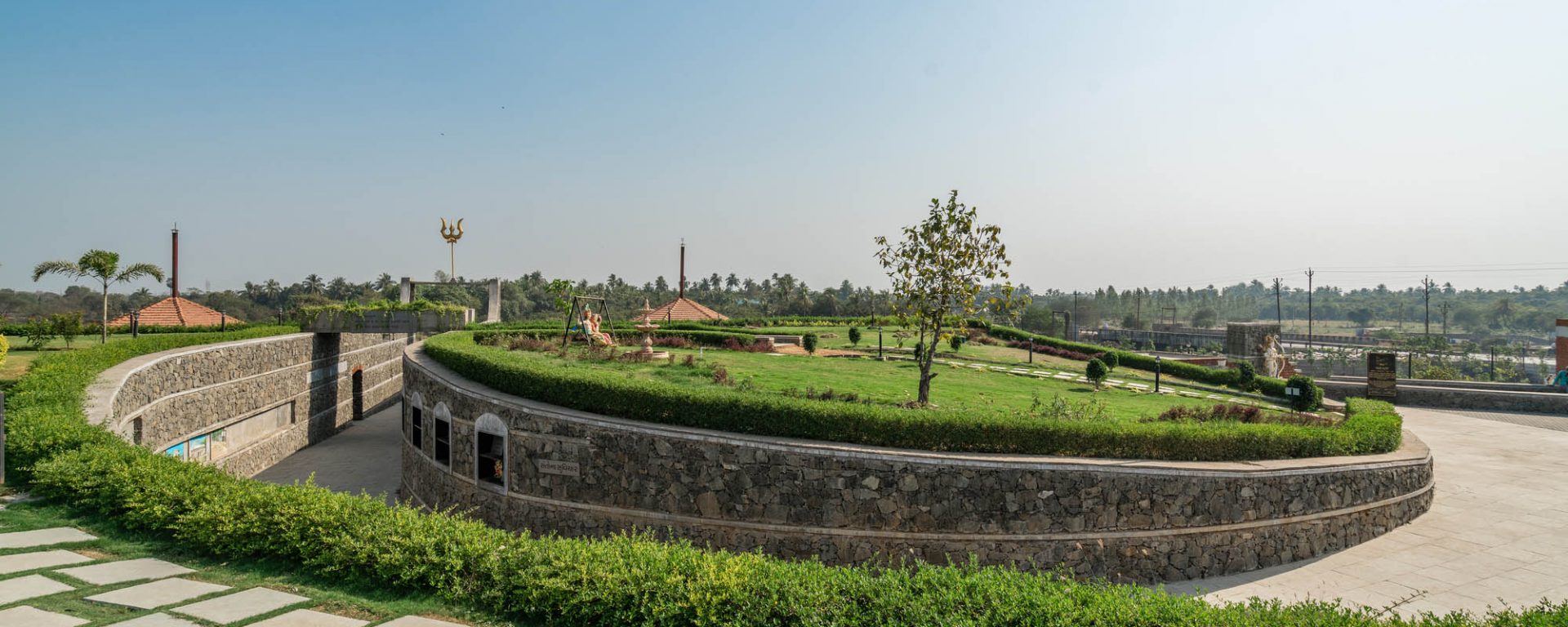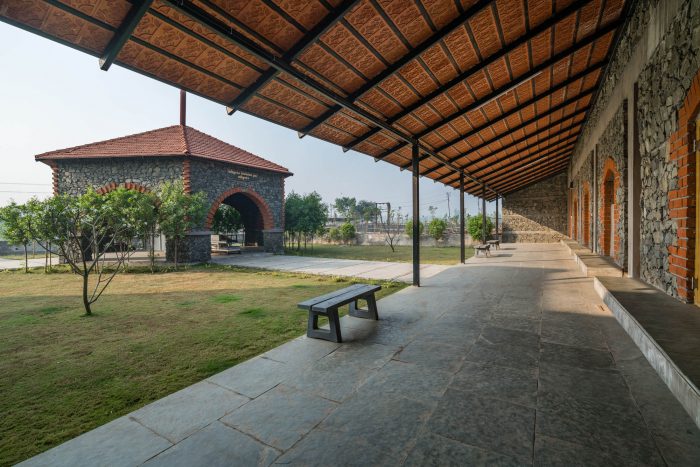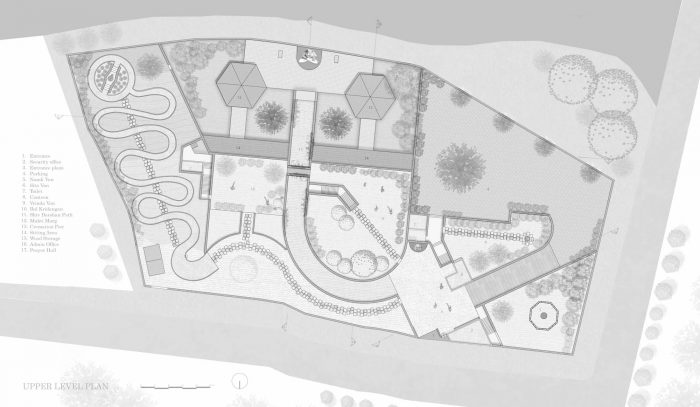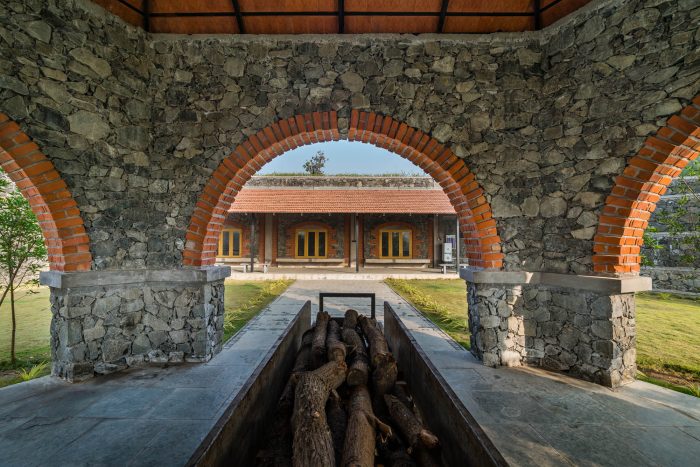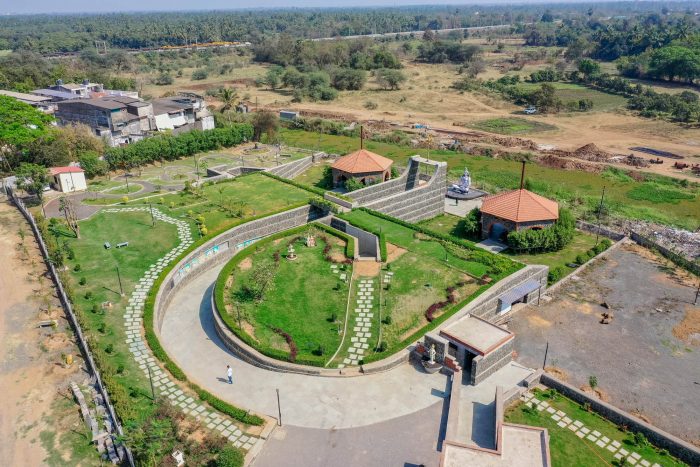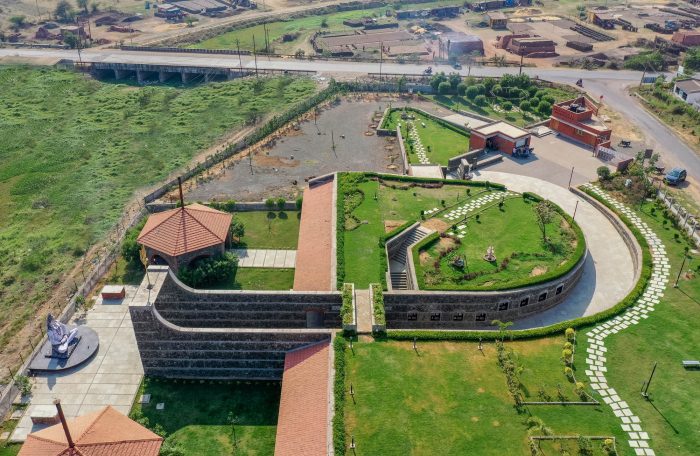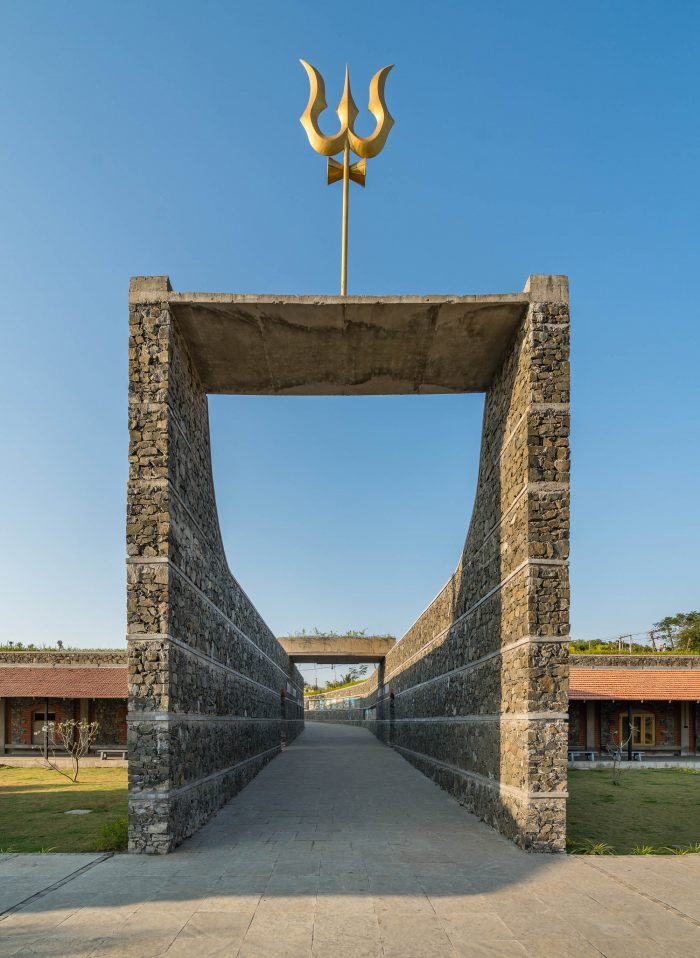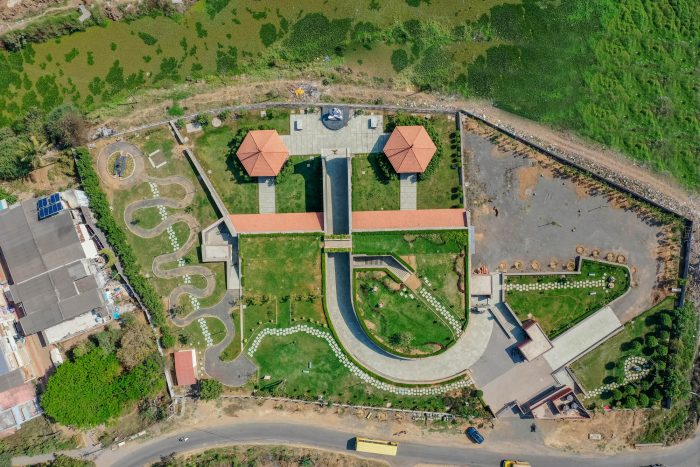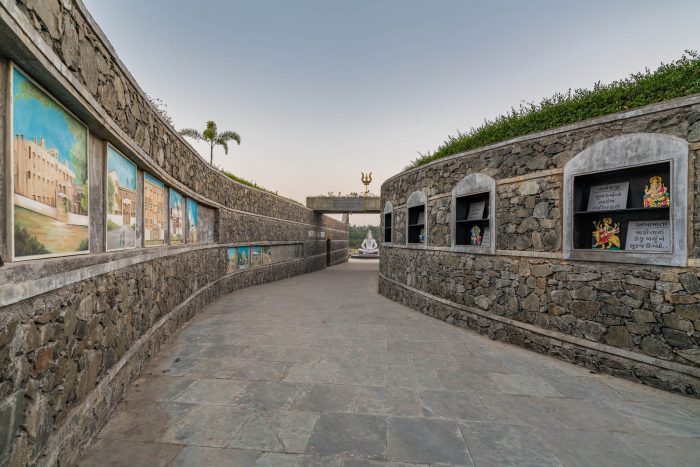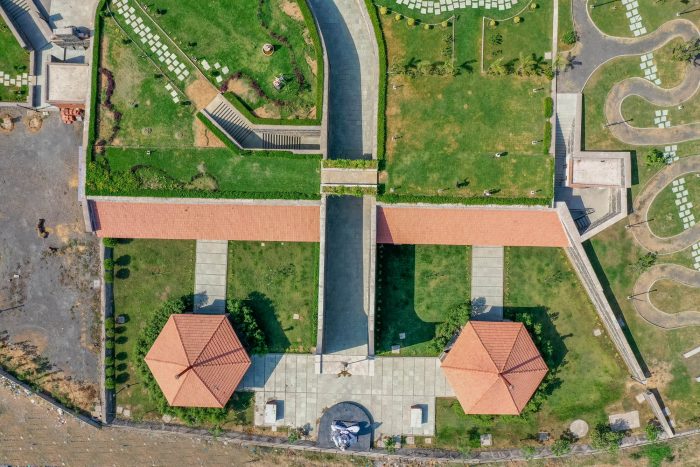仪式性的斜坡加深了精神公园和下沉式火葬场之间的过渡–迄今为止,我们对死亡的恐惧和不适使火葬场在城市背景下成为隔离、冰冷和压抑的空间。为了将印度阿玛尔萨德镇的这种表现不佳的印度教火葬场转变为一个重要的场所,d6thD设计工作室受一家私人信托机构委托。建筑师的想法是创造一个不仅限于履行火葬仪式的地方,而且在城市环境中创造急需的有价值的公共空间供日常使用。
Ceremonial ramp deepen transition between spiritual park and sunken crematorium – Our fear and discomfort with death have left crematoriums with segregated, cold and depressing spaces in urban context so far. To change such underperforming hindu crematorium into a vital place at Amalsad town in India, d6thD design studio had been commissioned by a private trust. Architect came up with the idea to create a place not limited to fulfil the cremation rituals but to make much needed valuable public space for daily use in the urban setting.
场地和入口–2英亩的场地北侧和西侧有相邻的道路,南侧有小河,东侧有少数住宅。场地从北到西南有5米高的松软地形。建筑师战略性地将一半的轮廓场地改造成两个主要层次–上层为公共空间,下层为火化空间,采用切割和填埋的方法。这两层都与被认为是仪式路径的坡道相连。
The Site and entry – 2 acre site has adjoining roads on north and west side, small river on south side and few residences on the east side. Site was having sloppy terrain of 5mt going down from north to south-west. Architect strategically transformed half of the contoured site into two major levels- upper level for public space and lower level for cremation space by cut and fills method. Both levels are connected with the ramp considered as ceremonial path.
从北面的道路到达入口广场后,游客被劝说放慢脚步,因为这里有看不见的建筑,并提供了多条路径。然而,部分可见的烟囱和黄金三叉戟激发了人们的好奇心。西侧的车道坡道通向停车场,游客可以通过连接两者的楼梯很快回到广场。
Upon arrival at entrance plaza from northern road, visitors are persuaded to slow down with invisible building and offered multiple paths. However, partly visible chimney and golden trident sparks the curiosity. A driveway ramp on west side leads down to parking area and visitors can return back to plaza shortly by using a staircase connecting the both.
灵性公园–上层完全由各种灵性花园组成,承认在印度的背景下,社会围绕着宗教发展,这样的空间往往不仅仅是一个奉献的地方。不太传统的是,这些空间满足所有年龄和性别的需求,而不考虑火葬场的部分;上层成为社会文化参与的重要公共空间。
Spiritual Park – Upper level is fully landscaped with various spiritual gardens in acknowledging the fact that in Indian context, society evolve around religion and such spaces often become more than just a place of devotion. Less conventionally, these spaces cater to all ages and genders regardless of the part of crematorium complex; upper level becomes a significant public space for socio-cultural engagement
西下层的Nandivan和Sitavan,而儿童游乐区和入口广场东上层的Vrindavan有助于分散公众的注意力。蛇形的波浪形道路通向最东边的标志性shivlinga,在火葬场和相邻的住宅单元之间提供缓冲。所有这些为当地人的日常使用而设计的空间都与不同层次的景观精心融合在一起,以尊重场地的轮廓条件。
Nandivan and Sitavan on lower west while children play area and Vrindavan on Upper East Side of entrance plaza help to disperse the public mass. Snake shaped wavy pathway leading down to an aniconic shivlinga on extreme east provide buffer between cremation courts and adjoining residential units. All these spaces designed for the daily uses by locals are carefully blended with landscape on various levels honor the contoured site condition.
仪式之路–5米宽、60米长的斜坡(Muktimarg)是在轮廓鲜明的公共公园中特别开凿出来的,将送葬者从入口广场带到隐藏的火葬场。当人们逐渐往下走时,挡土墙产生了轴心效应,完全集中了葬礼的气氛。 在坡道的开始,挡土墙上有当地城镇不同标志性建筑(学校、学院、寺庙、市场、火车站等)的壁画,作为对逝者的纪念。各种印度教圣人的小偶像和他们的名言;展示在挡土墙的壁龛里,创造了虔诚的气氛,以安抚死者的亲属。
Ceremonial Path – 5mt wide and 60mt long ramp (Muktimarg) peculiarly carved out of contoured Public Park, takes mourners down from entrance plaza to hidden crematorium. As one goes down gradually, retaining walls create shaft effect and solely focus funeral atmosphere. At the beginning of ramp, retaining walls hold murals of different iconic structures of the local town (school, college, temple, market, railway station etc) as the reminiscence of departed. Small idols of various Hindu saints and their quotes; displayed in retaining wall niches create pious atmosphere to calm the relatives of deceased.
在坡道中间,连接两个花园的桥,上面有悬挂的爬山虎,提供了宁静的环境。挡土墙顶部边缘的连续花槽软化了视觉效果,并作为花园的安全栅栏。
In the middle of ramp, bridge connecting two gardens on top with hanging creepers provides tranquility. Continues planters on the top edge of retaining walls soften the visual impact and act as security fence for the gardens.
进一步的曲线坡道令人惊讶地揭示了盛大的湿婆神雕塑;从入口处是看不到的。根据印度教的说法,在火葬场冥想湿婆,意味着对物质主义的冷漠,以及对人必须死亡并化为灰烬的一贯理解。它认识到这个世界,并将其囊括在 “创造、寄托和毁灭的哲学中–以Trishula为象征。为了强调这一点,湿婆神在视觉上被高高的石墙和坡道尽头有金色三叉戟的石板所框住。这条坡道的整个旅程鼓励人们从外部环境逐渐过渡到内部的亲密关系,从外部的噪音到内部的沉默,从创造的舞蹈到死亡的灰尘。
Further curvilinear ramp surprisingly reveal grand lord Shiva sculpture; which can’t be seen from entry level. According to Hinduism, Meditating Shiva in a crematorium speaks of aloofness from materialism and the constant understanding that one has to die and be reduced to ashes. It recognizes the world and encapsulates it in “the philosophy of creation, sustenance and destruction- symbolized by Trishula. To accentuate this, Lord Shiva is visually framed with elevated stone walls and the slab having golden trident at the end of ramp. This whole journey of ramp encourages the gradual transition from external environment to internal intimacy, from outer noise to inner silence and from dance of creation to the dust of death.
火葬空间 – 下层的下沉式庭院允许与外部的关系得到控制,从而提供了反思和纪念的环境。六角形的两个火葬台以对称的方式排列,由斜坡隔开,使两个葬礼可以同时进行,并具有隐私感。
Cremation Space – Sunken courts at lower level allow controlled relationship with exterior and thus provide environments for reflection and remembrance. Hexagonal shaped two cremation pyre are arranged in a symmetrical pattern separated by ramp gives the possibility of two funerals at the same time with the sense of privacy.
行政办公室、祈祷厅和木材储藏室被埋在地下,使其屋顶成为公共花园的延伸,并保持最小的视觉影响。这些地下设施可以从通往火葬场的宽阔走廊进入。这些半开放的空间成为等待区,在火化过程中,亲属们聚集在一起,共同感受失去的感觉。从等候区出来的楼梯直接通向上层的景观花园,避免了两个不同家庭之间的尴尬遭遇。使用当地可用的乱石和赤土屋瓦,不仅灌输了柔和的环境,而且还具有成本效益并经过时间检验。
Admin office, prayer hall and wood storage building are buried such that their roof top becomes extension of public garden and maintain minimal visual impact. These subterranean facilities are accessible from wide corridors opening to cremation courts. These semi open spaces become waiting area where relatives assemble for a shared sense of loss during cremation process. Staircases from waiting area become direct exit to landscaped garden on upper level avoid embarrassing encounters between two different families. Use of locally available random rubble stones and terracotta roofing tiles are not only instilling muted environment but also cost effective and time tested.
该项目鼓励游客探索不同的空间,并通过他们自己的经验和需求来解释其目的。通过实现死亡作为一个激励因素,在个人和社会层面上关注生命的意义;这个独特的火葬场–“Udan “成为该镇以及周边村庄的重要公共空间。
The project encourages visitors to explore the different spaces and interpret its purpose through their own experiences and needs.By realizing death as a motivating element to focus the meaning of life on both a personal and social level; this unique crematorium- “Udan” becomes an important public space for the town as well as the surrounding villages.
Architects: d6thD design studio
Area: 1000 m²
Year: 2020
Photographs: Inclined Studio
Manufacturers: AutoDesk, Jaquar, Adobe, Asian Paints, Daksh Prajapati, Larson and Toubro, NITCO TILES
Principal Architect:Himanshu Patel
Design Team:Nitin, Viraj, Amruta, Setu, Sriram, Athulya
Client:Saribujrang Nirvandham Trust
Architects:d6thD design studio
Project Managment:Phoonyx Consultant
City:Amalsad
Country:India

